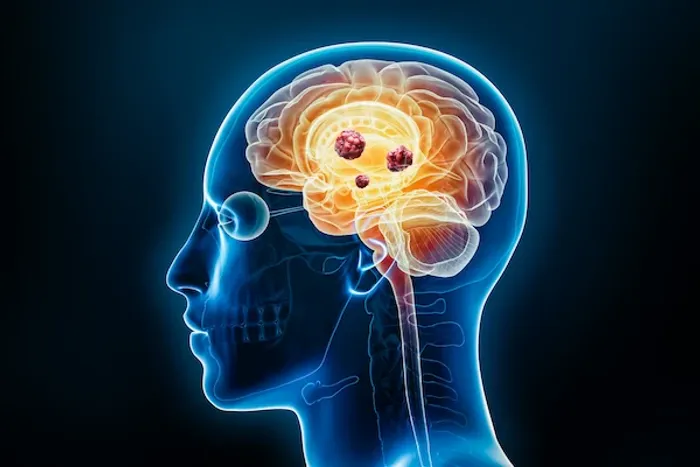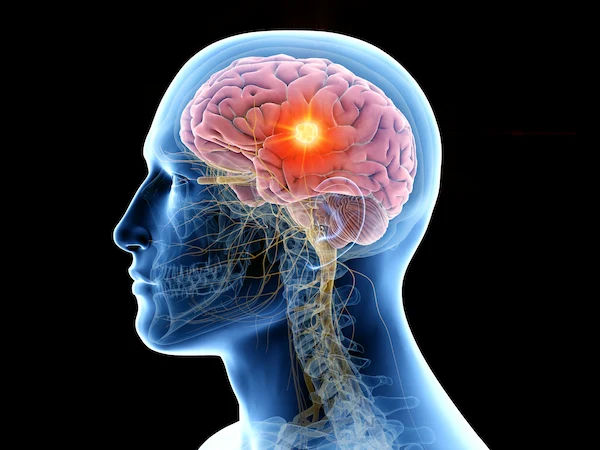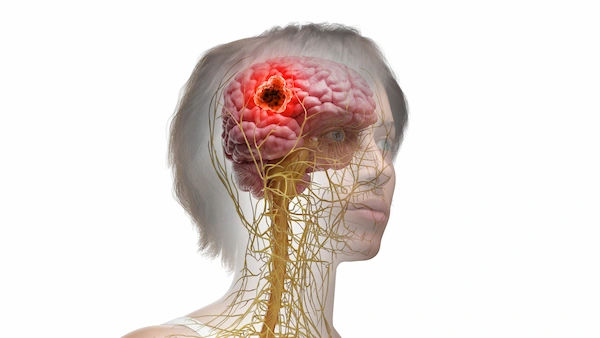Brain Tumour and Cancer: Your Essential Guide to Diagnosis and Treatment
Know about the brain tumour, what it is, signs, symptoms and causes. Learn about the grading of tumours and more.


Introduction
Hearing the words "brain tumour" can be terrifying, and it's natural for your mind to immediately jump to the word "cancer." The association is strong, but it's not always accurate. This guide is designed to demystify this complex topic, answering the critical question: Does a brain tumour mean I am suffering from cancer? We will walk you through the essential differences between benign and malignant tumours, explain how doctors make a diagnosis, and outline what to expect moving forward. Knowledge is power, and our goal is to replace fear with understanding and hope.
What is a Brain Tumour? The Basic Anatomy of a Diagnosis
At its core, a brain tumour is simply an abnormal mass of tissue in which cells grow and multiply uncontrollably. The skull is a closed space, so any extra growth inside it can cause problems by pressing on sensitive brain tissue.
Consult an Oncologist for Personalised Advice
Defining a Tumour: A Simple Analogy
Think of your brain's cells as well-behaved citizens following a strict growth plan. A tumour is like a group of cells that stops following the rules. They start multiplying out of control, forming a lump or a mass. This mass effect is what leads to many of the symptoms associated with a brain tumour, regardless of whether it is cancerous.
Primary vs. Metastatic Brain Tumours: Where It Starts Matters
This is a crucial distinction:
Primary Brain Tumours: These tumours originate in the brain itself. They can be benign or malignant. They are named after the type of brain cell they come from (e.g., meningioma arises from the meninges, glioma from glial cells).
Metastatic (Secondary) Brain Tumours: These tumours are always cancerous (malignant). They begin as cancer in another part of the body (like the lung, breast, or skin) and spread (metastasise) to the brain. Metastatic brain tumours are more common than primary brain tumours.
The Critical Difference: Benign vs. Malignant Brain Tumours
This is the heart of the matter. The terms "benign" and "malignant" define the tumour's behaviour, which directly answers the question of whether it is cancer.
Understanding Benign (Non-Cancerous) Brain Tumours
A benign brain tumour is not cancer. These tumours:
Grow slowly and are often well-defined.
Do not invade surrounding healthy brain tissue. They may push on it, but they don't intermingle with it.
Do not spread to other parts of the body.
Often have a low chance of recurring if they can be completely removed.
However, "benign" does not always mean "harmless." Because the skull is rigid, even a slow-growing, non-cancerous tumour can press on critical areas of the brain, causing significant neurological symptoms and requiring treatment.
Understanding Malignant (Cancerous) Brain Tumours
A malignant brain tumour is cancer. These tumours are more dangerous because they:
Grow rapidly
They are invasive, meaning they infiltrate and destroy surrounding healthy brain tissue.
It can sometimes spread to other parts of the central nervous system (like the spinal cord), though spreading outside the CNS is less common.
Have a higher tendency to recur even after treatment.
Key Characteristics Compared: Growth, Invasion, and Recurrence
| Characteristic | Benign Tumor | Malignant Tumor |
| Growth Speed | Slow | Fast |
| Invasion | Pushes on tissue, does not invade | Invades and destroys nearby tissue |
| Spread (Metastasis) | No | Yes, possible |
| Recurrence Rate | Low if fully removed | Higher |
Does a Brain Tumour Always Mean Cancer? The Direct Answer
No, a brain tumour does not always mean cancer. This is the most important takeaway. Many brain tumours are benign. For example, meningiomas, which are among the most common primary brain tumours, are approximately 90% benign. The diagnosis depends entirely on the specific type of tumour, which is determined by a biopsy and pathological analysis.
Grading Brain Tumours: More Than Just "Benign" or "Malignant"
Doctors use a grading system developed by the World Health Organisation (WHO) to classify brain tumours more precisely. This system helps predict how the tumour will behave.
The WHO Grading System Explained (Grade I to Grade IV)
Grade I: These are benign tumours. They grow slowly and are often curable with surgery alone.
Grade II: These are considered low-grade malignancies. They grow slowly but can be invasive and may recur as a higher-grade tumour.
Grade III: These are malignant tumours (cancer) with actively reproducing abnormal cells that invade nearby tissue. They tend to recur.
Grade IV: These are the most aggressive and fast-growing malignant tumours (e.g., glioblastoma). They are highly invasive and difficult to treat.
Recognising the Signs: Common Symptoms of a Brain Tumour
Symptoms depend on the tumour's size, location, and growth rate. They are not specific to cancer and can be caused by benign tumours as well. Common signs include:
New or worsening headaches, often worse in the morning.
Seizures.
Vision or hearing problems.
Nausea or vomiting.
Personality or behaviour changes.
Weakness or numbness in an arm or leg.
Difficulty with speech, balance, or memory.
If you experience persistent or worsening neurological symptoms, it is crucial to consult a doctor. If symptoms appear suddenly or are severe, consult a doctor online with Apollo24|7 for an immediate evaluation or seek emergency care.
From Symptom to Diagnosis: How Doctors Identify and Classify a Brain Tumour
Diagnosis is a multi-step process:
1. Neurological Exam: Checks vision, hearing, balance, coordination, and reflexes.
2. Imaging: An MRI (Magnetic Resonance Imaging) is the gold standard for visualising brain tumours. A CT scan may also be used.
3. Biopsy: This is the only definitive way to determine if a tumour is benign or malignant. A sample of the tumour tissue is removed (during surgery or with a needle) and analysed by a pathologist under a microscope.
Treatment Pathways: Tailoring the Approach to Your Specific Tumour
Treatment is highly individualised based on the tumour type, grade, location, and your overall health.
Treatment for Benign Tumours
Often, the primary treatment is surgical removal. If the entire tumour can be safely removed, it may be curative. For tumours in sensitive areas, partial removal followed by monitoring or radiation therapy may be recommended.
Treatment for Malignant Tumours
Treatment is typically more aggressive and multimodal, involving a combination of:
Surgery: To remove as much of the tumour as possible.
Radiation Therapy: To target and kill remaining cancer cells.
Chemotherapy: Uses drugs to destroy cancer cells.
Targeted Therapy & Immunotherapy: Newer treatments that target specific abnormalities in cancer cells.
Living with a Brain Tumour: Prognosis and Quality of Life
A brain tumour diagnosis is a life-changing event, but it is not a hopeless one. Prognosis varies enormously. Many people with benign tumours live long, full lives after successful treatment. Even for malignant tumours, advancements in treatment are continually improving survival rates and quality of life. A strong support system and access to specialised care are vital. If your condition requires ongoing monitoring, Apollo24|7 offers convenient home collection for tests that might be needed to track your overall health during treatment.
Conclusion
Receiving a brain tumour diagnosis is daunting, but understanding the critical difference between benign and malignant tumours is the first step toward empowerment. Remember, the presence of a tumour does not automatically equate to a cancer diagnosis. Many brain tumours are treatable, and medical science is advancing rapidly. The path forward involves partnering with a dedicated medical team to get an accurate diagnosis and create a tailored treatment plan. Stay informed, ask questions, and lean on your support network. With the right knowledge and care, there is always room for hope and positive action.
Consult an Oncologist for Personalised Advice
Consult an Oncologist for Personalised Advice

Dr. Sanchayan Mandal
Medical Oncologist
17 Years • MBBS, DNB Raditherapy, DrNB Medical Oncology
East Midnapore
VIVEKANANDA SEBA SADAN, East Midnapore

Dr.sanchayan Mandal
Medical Oncologist
17 Years • MBBS, DrNB( MEDICAL ONCOLOGY), DNB (RADIOTHERAPY),ECMO. PDCR. ASCO
Kolkata
Dr. Sanchayan Mandal Oncology Clinic, Kolkata

Dr. Gopal Kumar
Head, Neck and Thyroid Cancer Surgeon
15 Years • MBBS, MS , FARHNS ( Seoul, South Korea ), FGOLF ( MSKCC, New York )
Delhi
Apollo Hospitals Indraprastha, Delhi
(25+ Patients)

Dr. Rupam Manna
Radiation Specialist Oncologist
4 Years • MBBS MD(RADIO THERAPY)
Barasat
Diab-Eat-Ease, Barasat

Dr Gowshikk Rajkumar
Oncologist
10 Years • MBBS, DMRT, DNB in Radiation oncology
Bengaluru
Apollo Clinic, JP nagar, Bengaluru
More articles from Brain Tumor
Frequently Asked Questions
1. What is the most common type of benign brain tumour?
2. Can a benign brain tumour become cancerous over time?
It is rare, but some low-grade (benign or Grade II) tumours can transform into higher-grade, malignant tumours over many years. This is why ongoing monitoring is often recommended.
3. What are the survival rates for malignant brain cancer?
Survival rates vary significantly based on the tumour type, grade, patient's age, and overall health. For instance, the five-year survival rate for a Grade IV glioblastoma is lower than for a Grade II astrocytoma. Your oncologist can provide statistics relevant to your specific situation.
4. Are there any known causes or risk factors for brain tumours?
For most brain tumours, the cause is unknown. The only well-established environmental risk factor is high-dose exposure to ionising radiation. A small percentage of tumours are linked to inherited genetic syndromes.
5. If a brain tumour is cancerous, does it always mean it's terminal?
No. While malignant brain tumours are serious, they are not universally terminal. Many factors influence outcomes, and 'terminal' is a term used for cancers that cannot be cured and will likely end life. Many people live for years with malignant brain cancer as a chronic illness, thanks to effective treatments.




